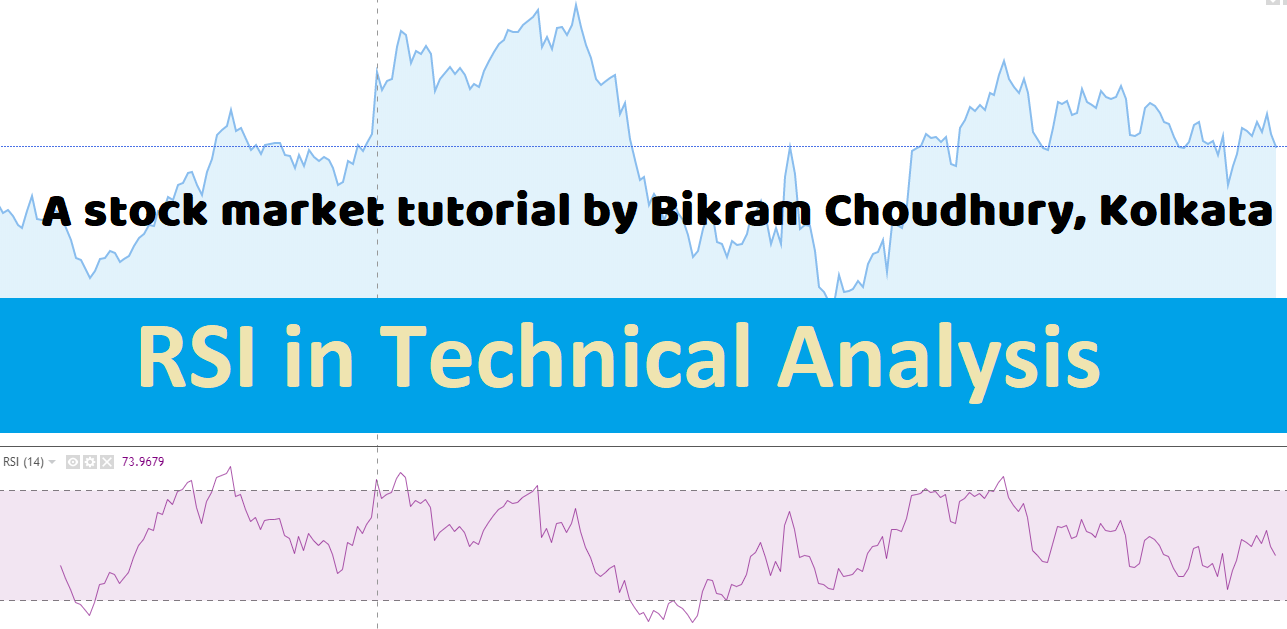Share Trading Course > Technical Analysis for beginners > RSI
RSI the most popular indicator give strongest signal to buy or sale stock in the non trending market, which is also called the sideways or range trading market.

RSI calculation formula:
Average gain = ( total gain in last consecutive n time frame) / n
n is a number called the look back period and default value is 14.
The number n = 14 is called the look back period. 14 is the default value for n, mentioned as days here, but keep in mind that 14 can be 1-hour time frame, (1 minutes time frame), (15 minutes time) or “5 minutes time frame” in the chart. We are viewing daily charts and n is 14 days.
- n = last 14 trading days
- Average loss = (total loss in last 14 days) / 14
- Avg Gain = (total profit in last 14 days) / 14
- RS / Relative Strength = avg gain / avg loss
- RSI = 100 – (100 / (1+RS) )
How to measure overbought zone using RSI indicator
When the RSI > 70 (in some cases> 80) it is said the stock is in overbought zone, i.e the stock has been bought to the maximum level and now selling is coming due to profit booking.
The stock should not be in strong uptrend or downtrend
The overall trader’s sentiment is “the stock price has been reached to the maximum level and in the coming days the share price is going to fall. So when RSI indicator is greater than 70 or 80, then you can take a position of selling (shorting) on that stock.
Not only stock RSI indicator is equally applicable on market index NIFTY chart, or Currency chart.
Warning: The stock or Nifty or BankNifty on which you are trading , and checking the RSI indicator, should be in range trading mode & not in strong uptrend or downtrend for the period on which you are looking it.
Range trading, sideways market explained
Ranging market means that the overall market Index like NIFTY value is oscillating between a maximum and minimum value for quite some time like 15 days or 1 month or some more days. It has been reached the maximum or minimum value at least twice in past, so that you can identify maximum and minimum range. This type of market is called range trading market or sideways market. The same rule is applicable for a stock price, when a stock price is range trading.
What is strong trending stock ?
In a strong trending stock, the stock price goes high, high and high with small correction forming higher top and higher bottom formation in strong uptrend.
So how to detect the oversold zone using RSI ?
Oversold means the stock has been sold to the maximum level and the new buyers are coming in and the stock price is going to rise very soon in near future, that is the stock which was in down for quite some time, is now going to to reverse the direction of trend. It may go sideways or may go uptrend.
Say, for the last few days ( 15 days or more ) the stock was in selling mode. But now RSI value less than 30 (or < 20) in daily chart. So you can assume that the stock has reached to the oversold level and now it is time to buy or go long. The RSI indicator is equally applicable for a stock , or an index like NIFTY, or currency, commodity or other trading instruments.
Keep in mind, here downtrend means the stock is not strong downtrend, rather it is range trading & heading towards range bottom. It gone up to the maximum level in past & now going down to test the support level. That the stock price oscillates between a maximum and minimum price level.
So from minimum to maximum direction the stock is up trending, and from maximum to minimum it is down trending, while the stock is overall range trading. Stock Market investment plan
False RSI signal generated when the stock in strong uptrend
Never mix this with a stock which is strong up-trending or a strong up-trending market index. In strong uptrend or strong downtrend the RSI generates signals in a different way. In strong up-trending cases RSI indicator stays at overbought zone for a long time, and generate false signals for the sellers or short sellers. Maximum time people think that it has gone to the overbought zone and if the short they will face loss eventually. No sooner the price goes up.